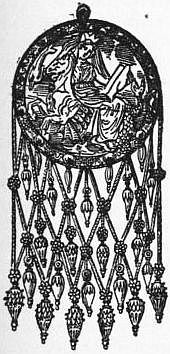Ear-Ring
 From Britannica 11th Edition (1911)
From Britannica 11th Edition (1911) Ear-Ring, an ornament worn pendent from the ear, and generally suspended (especially among the more civilized races) by means of a ring or hook passing through the pendulous lobe of the ear. Among savage races the impulse to decorate, or at any rate to modify the appearance of the ear, is almost universal. With such peoples the ear appendage is chiefly remarkable for its extravagant dimensions. Many examples may be seen in the ethnographic galleries of the British Museum. The Berawan people of Borneo use plugs through the lobe of the ear 3¾ in. in diameter. More extraordinary still is an example of a stone ear-plug worn by a Masai, 4½ in. in diameter and weighing 2 ℔ 14 oz. (Man, 1905, p. 22). It is stated that according to the Masai standard of fashion, the lobes of the ears should be enlarged so as to be capable of meeting above the head. Among the superior races, though ear ornaments of extravagant size and elaboration are not unknown, moderation in size is commonly observed, and greater attention is paid to workmanship and fineness of material.
 |
| From La Grande Encyclopédie. |
| Fig. 1.—Ear-ring from an Assyrian bas relief. |
 |
| From La Grande Encyclopédie. |
| Fig. 2.—Thetis crossing the sea, with the armour of Achilles. Ear-ring from the Crimea, Hermitage museum. |
The general usage appears to have been to have ear-rings worn in pairs, the two ornaments in all respects resembling each other; in ancient times, or more recently among Oriental races, a single ear-ring has sometimes been worn. The use of this kind of ornament, which constantly was of great value, dates from the remotest historical antiquity, the earliest mention of ear-rings occurring in the book of Genesis. It appears probable that the ear-rings of Jacob’s family, which he buried with his strange idols at Bethel, were regarded as amulets or talismans, such unquestionably being the estimation in which some ornaments of this class have been held from a very early period, as they still are held in the East. Thus in New Zealand ear-rings are decorated with the teeth of enemies, and with talismanic sharks’ teeth. Among all the Oriental races of whom we have any accurate knowledge, the Hebrews and Egyptians excepted, ear-rings always have been in general use by both sexes; while in the West, as well as by the Hebrews and Egyptians, as a general rule they have been considered exclusively female ornaments. By the Greeks and Romans also ear-rings were worn only by women, and the wearing of them by a man is often spoken of as distinctively oriental.
In archaic art, ear-rings are frequently represented or their traces are left in the perforated ear lobes of early statues. After the 4th century such perforations occur seldom. In one instance, a Greek inscription records the weight of the detachable gold ornaments on a statue, among which a pair of ear-rings is included. Ear-rings of characteristic form are frequently discovered by excavation. In Egypt, a system of pendent chains is found hanging from a disk. In Assyria the decoration consists of pendants or knobs attached to a rigid ring. In the early civilization represented by Dr Schliemann’s Trojan investigations, pieces of gold plate are suspended by parallel chains. In the Mycenaean period, ear-rings are infrequent in Greece, but have been found in abundance in the Mycenaean finds of Enkomi (Cyprus) in the form of pendent bulls’-heads, or of decorative forms based on the bull’s head. In the tombs of the Greek settlers in the Crimea (4th century B.C.), ear-rings are found of marvellous complexity and beauty. The lexicographer Pollux, speaking of the names given to ear-rings, derived from their forms, mentions caryatids, hippocamps and centauresses. Jewels of the same class, of exquisite beauty and of workmanship that is truly wonderful, have been rescued from the sepulchres of ancient Etruria. Ear-rings of comparatively simple forms, but set with pearls and other stones, were the mode in Rome. In some instances, the stones were of fabulous value. During the Byzantine period they once more attained an extravagant size. Researches among the burial places of Anglo-Saxon Britain have led to the discovery of jewels in considerable numbers, which among their varieties include ear-rings executed in a style that proves the Anglo-Saxons to have made no inconsiderable advances in the arts of civilization.
These same ornaments, which never have fallen into disuse, enjoy at the present day a considerable degree of favour, and the tide of fashion has set towards their increased use. Like all other modern jewels, however, the ear-rings of our own times as works of art can claim no historical attributes, because they consist as well of reproductions from all past ages and of every race as of fanciful productions that certainly can be assigned to no style of art whatever. As one of the curiosities of the subject it may be mentioned that Antonia, wife of Drusus, is said by Pliny to have attached a pair of ear-rings to her pet lamprey.
↧ Download as ZWI file | Last modified: 11/17/2022 15:24:36 | 4 views
☰ Source: https://oldpedia.org/article/britannica11/Ear_Ring | License: Public domain in the USA. Project Gutenberg License
 ZWI signed:
ZWI signed: KSF
KSF